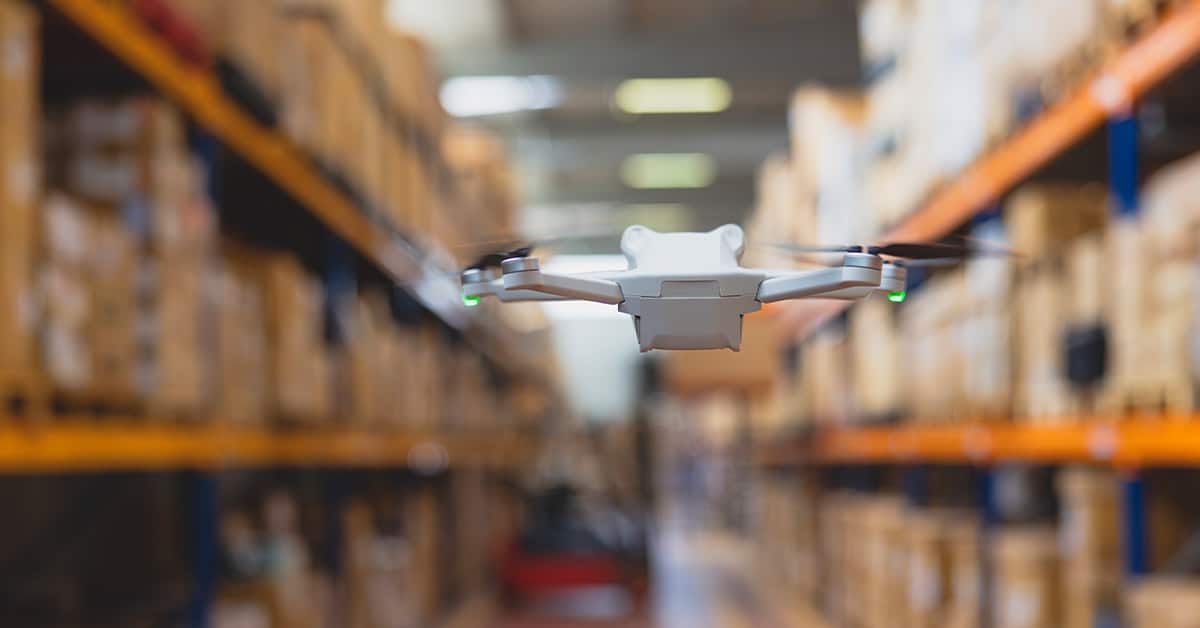Carrying out essential maintenance checks on a large site or campus can involve a lot of walking, driving or climbing. This is time when the technician isn’t productive and could be at risk of slips, trips or falls. Drones provide an alternative, saving time and keeping people safe.
This blog explores how businesses are using drones for industrial inspections. After a brief introduction, it discusses drone applications in industrial maintenance, the benefits of using drones and potential challenges.
What are industrial drones?
Drones are unmanned aerial vehicles (UAVs) piloted from the ground. While they have been used by hobbyists, amateur and professional filmmakers, and the military for some time, the use of drones for maintenance is still quite new.
The drones most people are familiar with are the multi-rotor design. Usually, these have four rotors providing lift, stability while hovering and forward motion. For larger payloads, drones are available with five, six or more rotors. Fixed wing and single rotor drones are also produced, but these are more expensive and harder to operate.
Drones are often equipped with high resolution cameras or thermal imagers and used to get pictures from angles and directions otherwise difficult or impossible to achieve. Some companies are equipping drones with probes for performing ultrasonic and dry film thickness measurements as a way to carry out remote industrial machine inspection.
Like machine health monitoring systems and Industry 4.0, industrial drone inspection is another emerging maintenance technology in manufacturing. It provides a relatively fast way to view remote or otherwise inaccessible areas of a plant or facility. This saves technician travel time, eliminates the need to climb ladders or use aerial work platforms, and can avoid having to shut down equipment for inspection.
Applications in industrial maintenance
There are two situations where drones are useful for performing inspections on industrial assets:
- Assets are not readily accessible to maintenance technicians, for example, because they’re high in the air or at a distance
- Human inspection requires equipment be shut down for safe access
Equipment and machinery monitoring
Drones are being used to inspect pipelines and electrical cables. They can also monitor overland conveyors, cranes and other heavy-duty machinery.
Facility and infrastructure inspections
A drone can fly over a building roof to discover areas of damage, or, if using thermal imaging, detect areas of heat loss. Drone asset inspections like these can also be carried out inside large buildings for tasks like checking rafters and other inaccessible spaces.
Safety and compliance audits
Flues and tanks often require checks on metal or coating thickness. A drone can carry out this kind of asset inspection using ultrasonic or dry film thickness measurement probes, while the equipment is in use, rather than needing it shut down and cool.
Integrating drones into maintenance routines
If, after conducting trials, drone asset inspection is seen as having value, it should be integrated into the preventive maintenance (PM) system coordinated through the CMMS. As with other machine inspections, this means establishing a schedule, having the CMMS issue work orders, assigning the job to suitably trained technicians and analyzing the results. For consistency between inspections, images should be captured from the same position every time.
Industrial drones are not inexpensive pieces of equipment, and they need a skilled pilot to maneuver them as necessary. Drones must be registered with the FAA and their pilots should have appropriate certifications. Businesses using drones for industrial inspections report that two technicians are needed, one to fly the UAV and one to operate the camera or other equipment.
Data acquired during drone inspections should be treated like other machine health records and analyzed, stored and acted upon by trained personnel. Results of previous inspections should be readily available for comparison and assessment of gradual degradation.
Challenges and considerations
As noted, there are regulatory issues to address before using drones for maintenance tasks, and this should be factored into the cost-benefit analysis.
One point sometimes overlooked is that certified drone pilots must maintain visibility of the UAV they are operating, which can reduce some of the potential savings in technician time. Furthermore, the need for two technicians does add to the cost of performing drone asset inspections.
The key to achieving a good ROI from drone inspection is to have applications where it yields significant cost savings and/or safety improvements. For example, working at height is always hazardous and often requires the use of expensive work platforms and even cranes. Performing these inspections by drone can provide significant cost savings.
A second benefit to consider is that drones can eliminate the need to shut down equipment for human inspection. Work on stacks and flues is a prime example, where allowing these to cool can mean several days of shutdown, whereas a drone can make the same checks while the processes are running.
Optimizing industrial maintenance operations
As awareness of the value of drones for remote imaging grows, so too does the number of maintenance applications identified for them. By performing inspection work in hard-to-reach areas, industrial drones help keep maintenance technicians safe while simultaneously improving their productivity.






